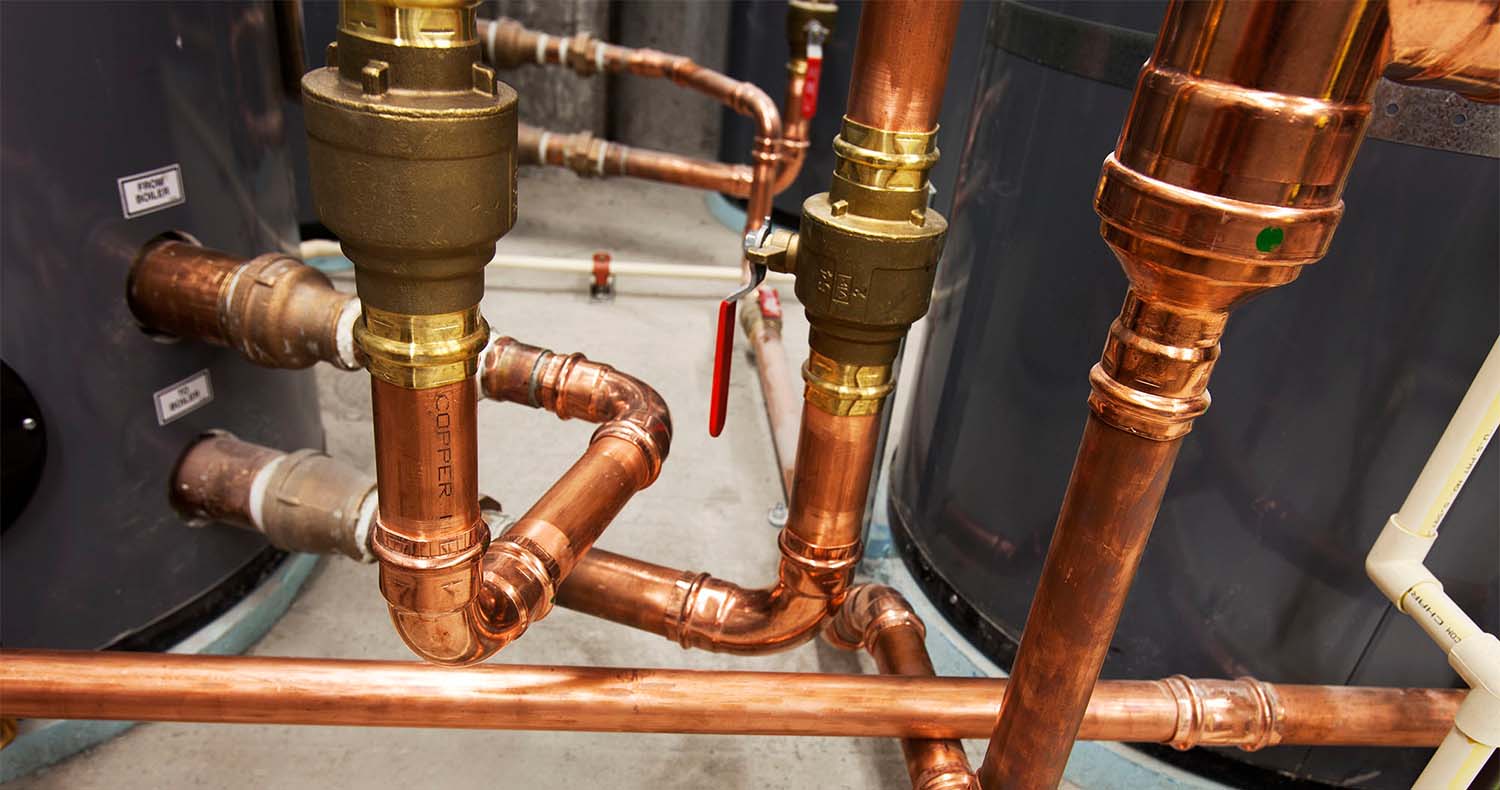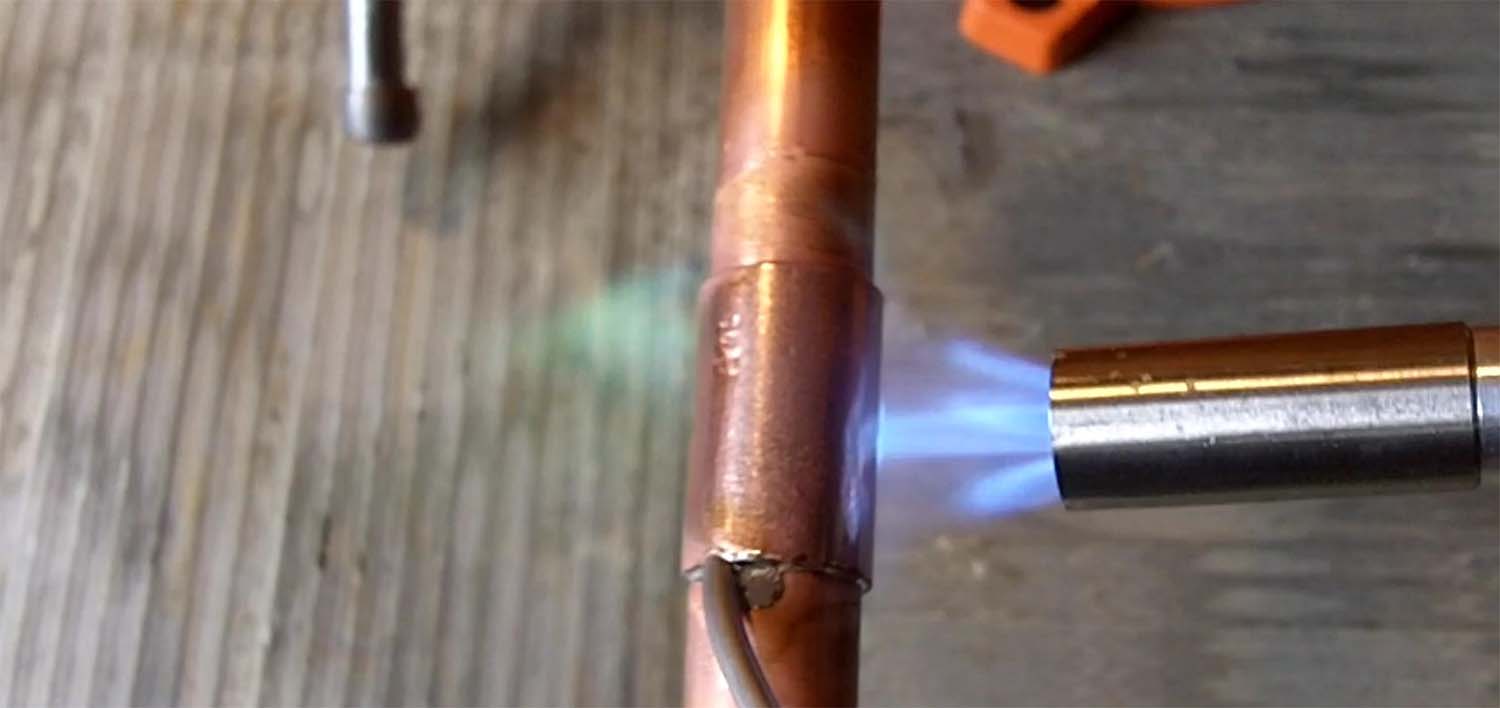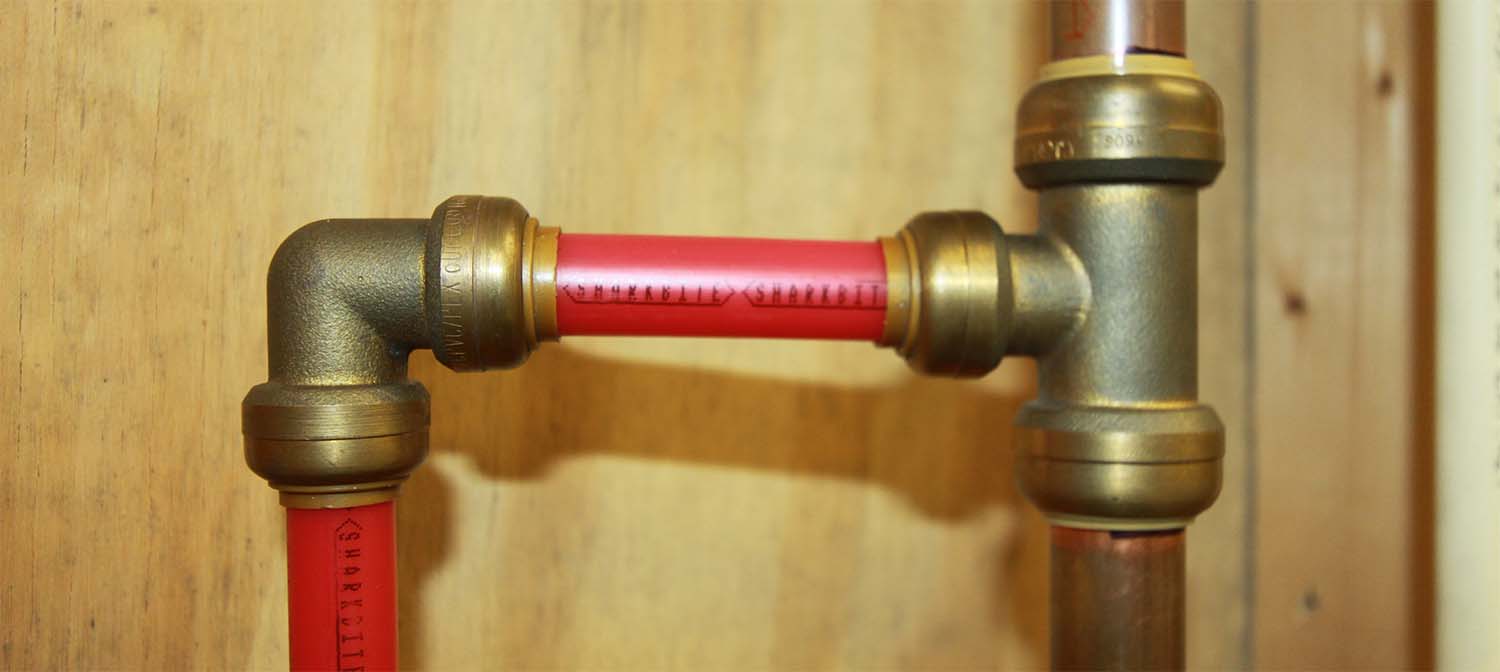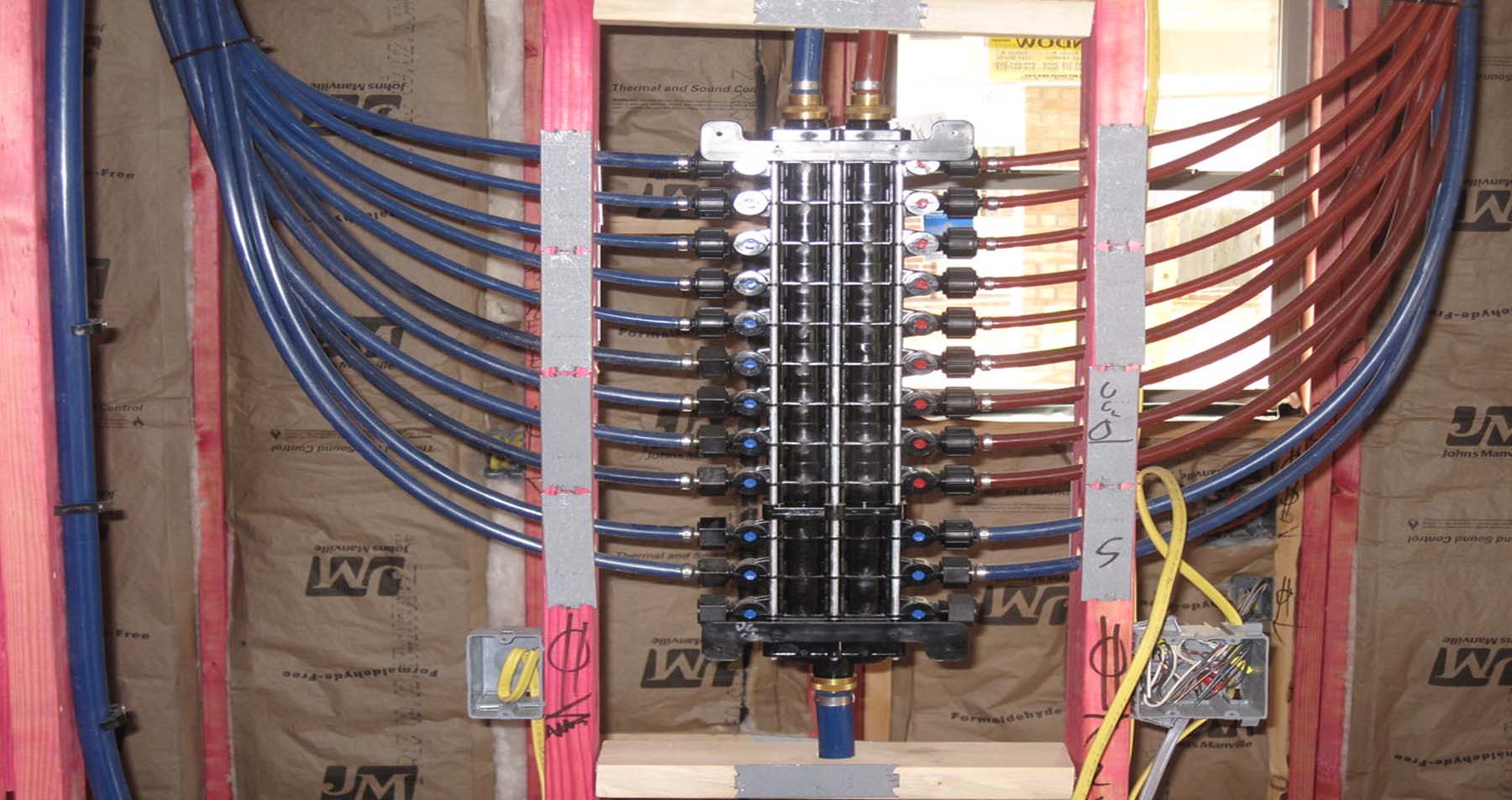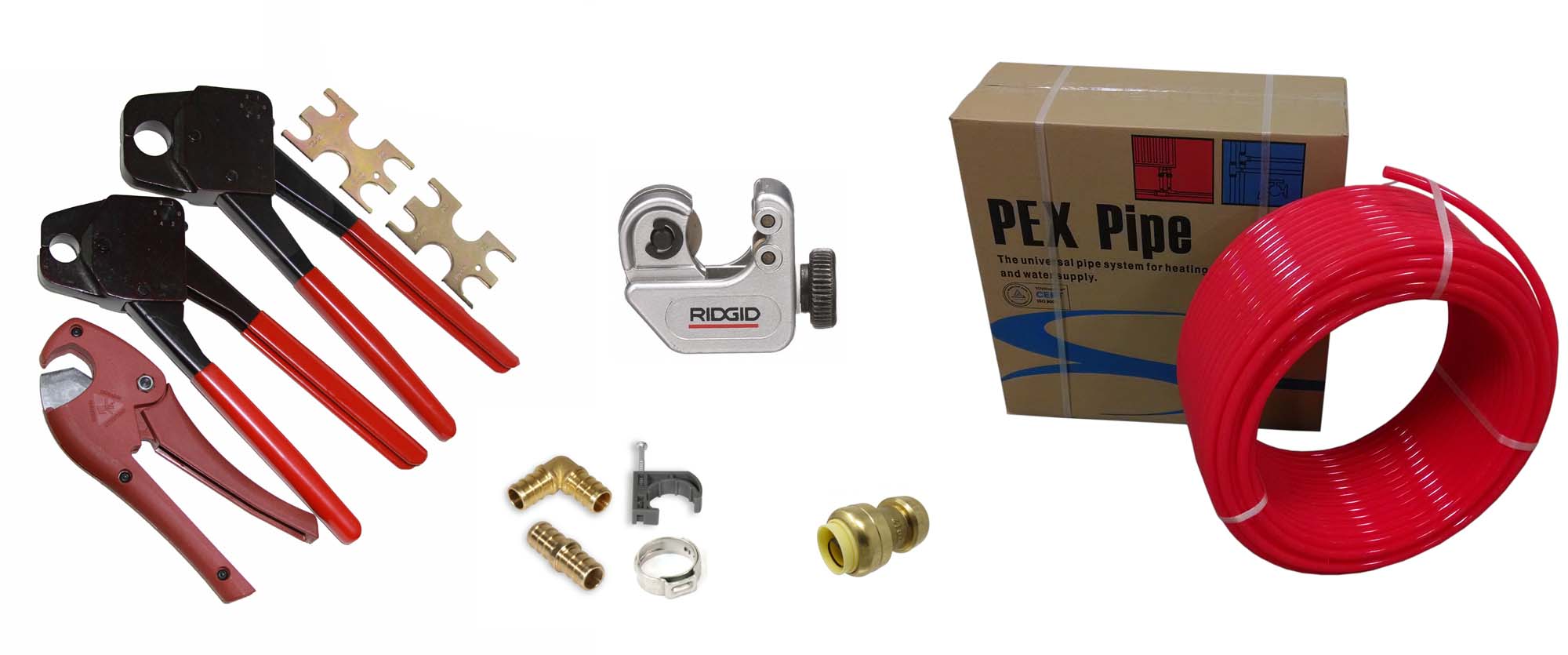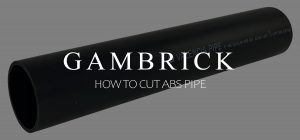PEX vs Copper Pipe
For decades copper pipes were the standard in residential piping. Every home had copper pipes run throughout the home supplying all the hot and cold water to just about wherever it was needed. And then along came PEX and inevitably the comparisons and lots of questions. PEX vs Copper. Which is better? Which ones cheaper. What type should I use in my house. Which has the best warranty and lasts the longest. What are the advantages and disadvantages of each and what’s the difference. They just supply hot and cold water to stuff, right? Does it really matter if you install PEX vs Copper plumbing lines.
In this article we’ll discuss in depth both PEX and copper piping and why some prefer one vs the other. We’ll look at what PEX and copper are, how they’re made, installed and what they’re made of. And we’ll review the different types and sizes of both materials such as PEX A-B and C, what are they and what’s the difference. PEX Manifolds systems, different way to connect PEX and a lot more…
Copper Pipes
Considered the plumbing standard for a very long time. Copper pipes are rigid metal that have historically been connected to one another with a variety of fittings and solder. For years, installers had to know how to “sweat” or solder pipes together with a blow torch. Soldering makes the physical, hard connection from pipe to pipe. However today’s plumbers have the option of using compression fittings to make connections from pipe to pipe without the use of solder.
Copper has natural attributes that make it perfect for plumbing. It creates an atmosphere which makes it difficult for bacteria to grow inside the pipes. It also resists corrosion and is unaffected by ultraviolet rays which allows you to use it outdoors. And it’s a hard rigid pipe which makes it hard for rodents to gnaw into like they can with PEX.
Copper does have a few disadvantages though. Copper has become expensive, whereas PEX has actually gone down in price. It can still corrode based on the pH levels of water and if you live in a cold climate, freezing water can cause pipes to burst if they’re not insulated properly.
Copper is also harder to install than PEX. It’s a hard pipe so you can’t easily snake it around the house like you can with PEX. You’ll need all sorts of fittings to make right angle turns. It’s a lot more work.
Copper Pipe Pros and Cons
- Recycling: About half of the copper used in this country, which includes plumbing pipes and fittings, is created from recycled copper according to the copper industry’s trade group, Copper Development Association, Inc. (CDA). Copper is worth a lot of money and is easily recycled so there’s an incentive to recycle it.
- Rigid: PEX’s flexibility is great when you want to snake around corners but bad when you need to stub out to a toilet or sink. For that we buy a special PEX fitting. That blue pipe sticking out of the wall running to your toilet looks really bad. Sometimes a rigid metal pipe just works better. Because it’s a hard metal it’s also resistant to rodents biting at it which is a big problem with PEX. In fact NYV banned the use of PEX inside the city for this exact reason.
- Heat resistant: PEX is heat resistant and works great for under floor radiant heating. But for high heat applications like your water heater, you need to make that final connection with copper or some other metal like stainless steel or brass.
- No toxic fumes: PEX is plastic and will melt in a fire giving off toxic fumes. Copper won’t.
- Cheaper fittings: If you use standard copper fittings and solder they’re much cheaper than SharkBite or other compression fittings. In most cases they’re about 10 times less. Although you do have to know how to solder.
- Copper has value: Any left over copper you have can be brought to a recycle center and traded for cash. It’s a real metal that has real value. Left over PEX is worthless.
PEX Piping
Introduced in the US around 1980 and first used in radiant floor heating, PEX is now considered the standard piping for use throughout most residential and commercial construction.
There are so many advantages to using PEX including cost, flexibility, and fast installation with fewer connections and fittings. Although PEX isn’t suitable for use outdoors because animals can easily chew through it, it’s much more resistant to freezing and bursting because it’s flexible.
PEX is color coded based on water temperature (red is hot, blue is cold, white is any) which is a nice feature although copper is better here as copper pipes can be used anywhere for any applications. You don’t want to use a blue PEX pipe for hot water.
Installing PEX pipingis super easy and can be done with crimp rings and a clamp tool or compression fittings. Either way is easier and less work than sweating copper.
PEX is much easier to snake throughout a house because it’s flexible. You don’t have to use a bunch of cuts and fittings like you do with copper.
PEX uses a manifold system to run water to individual fixtures. You’ll read more about this below. It’s a fantastic system that much better than using copper.
PEX Pipe Pros and Cons
- Easy to work with: PEX is easy to work with. All you need are clamps and a crimp tool or compression fittings. No need for soldering or using a torch.
- Easy to cut: Copper pipes need a special tool to cut them evenly. The same tool is used for PEX but it’s a lot easier. And you can also use a cutting tool that looks like a scissor. It’s a softer material so it’s just easier to do. This may not seem like a big deal but if you make a few 100 cuts a day it is.
- Lower cost: PEX is much cheaper than copper pipe and doesn’t require nearly as many fittings.
- Flexible: It’s easy to snake PEX wherever you need it to go without needing a bunch of right angle fittings. This saves a lot of time and money.
- Fast: It’s much faster to plumb a house with PEX than it is with copper which will make you money.
- Manifold: The PEX manifold system is so much better than what’s used with copper it’s not even close. What the manifold system is and how it works will be discussed below.
- More expensive fittings: You don’t need as many fittings as you do with copper but when you do need them they’re expensive. Compression fittings are copper are just as expensive but they have much cheaper options.
PEX vs Copper Lifespan: Which Lasts Longer?
Copper pipes are hard to beat in terms of longevity and have a very long track record of solid performance. We can look at homes with copper piping that’s 100+ years old and see how it’s all held up and if they’re were any failures where and why did they occur. And then we can make adjustments to prevent failures in the future. We can’t do that with PEX. It’s too new. No one can tell you how it should perform in 50 years because no one really knows.
Manufacturers say copper pipes should last on average 50 to 70 years compared to PEX, which has an expected lifespan of 30 to 50 years.There are a lot of other factors that go into this comparison like system design and installation skill but assuming the systems are both designed and installed correctly, copper wins hands down. If I was building my own home I’d install copper. It’s just a better material than PEX and time tested to last.
Now that’s not to say there’s anything wrong with using PEX. We use it on the vast majority of homes we either build or remodel. It just doesn’t last as long.
Both PEX and copper pipes can fail prematurely from a number of very common issues we’ll list below.
Common Reasons For Premature Failure With Pex Pipes
- The use of extremely hot household water, 180 degrees Fahrenheit or higher, or if the water in the home contains high levels of chlorine.
- PEX is susceptible to rodent and UV damage. Don’t leave PEX piping in the sun, use it outdoors or under a house or crawl space where animals can gnaw on it. NYC actually bans the use of PEX anywhere in the city due to the rats. They’ll chew right threw it causing leaks. They require hard piping only which rats can’t damage.
- Because of how flexible PEX pipes are they can move inside the walls when water is turned off and on. Remember PEX isn’t a rigid pipe like copper. It has a lot of play in the line. You can use this by tightly strapping the pipes inside the walls to studs. If you don’t they’ll eventually leak.
- Improper installation.
- Failure at one of the valves.
- Failure at one of the connecting fittings.
- Poor manifold design.
Common Reasons For Premature Failure With Copper Pipes
- Copper pipes can fail from carrying highly acidic water. When installed under normal conditions with regular city water, copper can be expected to outlast PEX by at least 20 years. However if you have a private well have your water tested to determine whether it’s high in acid or chlorine.
- Installation errors due to soldering joints.
- Improper strapping during installation can cause pipes to vibrate inside the walls, which creates a banging sound, when under pressure from running water. This can eventually cause a leak at one of the solder points.
- Failure at one of the valves.
Pex vs Copper Cost: Which Costs More?
The cost of copper has risen substantially in resent years and continues to do so just like other metals. Because of this increase products made from copper, like pipes, have increased as well. Even though with PEX you have to buy all sorts of additional supplies and fittings to make the system work it’s still a lot cheaper than copper.
It’s actually so much cheaper that converting to PEX pipes for small jobs is actually worth it. They sell compression fittings that are super simple to use. You just push them on the edge of the copper pipe and then run your PEX. A few years ago it was worth using copper for small jobs on older homes that had copper pipes. But not any more. The cost of copper keeps going up and PEX prices have actually come does some due to increased competition and volume orders.
On average, installing copper water pipes will be about 60% – 70% more expensive than PEX. For example, we paid our plumber $14,000 to install PEX on a new custom home we built last year. 3400 Sq. Ft., 4 bath, kitchen, laundry, etc. All the standard stuff you find in homes throughout the area. Nothing too custom in the showers. We bid out the exact same house with the exact same fixtures in copper just for comparison and it came to just under $24,000.
That’s a huge difference on your average house and homeowners just don’t want to pay it. In terms of cost PEX is the clear winner here.
Pex vs Copper: Water Flow Rate
A little known detail about using PEX is that PEX fittings go INSIDE the pipe. They are therefore slightly smaller in diameter which negatively effects water flow rate. For example a 3/4 PEX fitting is equally as wide as a 1/2 copper fitting. So if you work with PEX you have to figure the system differently than if your used to working with copper.
A short distance of restriction does not reduce water flow as much as a longer section of smaller diameter piping because water can speed up through a small area. PEX also has smaller fittings but doesn’t have as many right angles throughout the system because the lines can be bent. No right angles means better water flow. Calculating the rate of water flow throughout a home is an important part of plumbing system design and should only be done by either a qualified plumber or an MEP engineer.
So as a general rule of thumb, switching from 1/2″ copper to 1/2″ PEX for long distances would reduce water flow somewhat, but for short distances you won’t notice it and in some cases can actually have the effect of increased pressure at the fixture.
If your used to piping an entire house with 1/2″ copper you can’t just go to 1/2″ PEX. You won’t have the same water pressure. The system has to be designed for either copper or PEX piping. If you switch between the two for whatever reason, usually in older homes, we up size the PEX for long runs and stay the same for short ones.
Does PEX Piping Freeze Like Copper?
Most builders prefer using PEX piping over copper in areas where freezing is an issue because there’s a lot less risk of burst pipes. PEX doesn’t degrade like copper which can weaken areas of the copper pipe making them more susceptible to cracking. And PEX is a lot more resistant to breakage than copper or rigid plastic pipe because it’s flexible. If water freezes inside the pip PEX can flex and give a little, rigid pipes can’t.
Some people ask the question, does PEX freeze? What they’re really asking is will the pipes burst like copper can. And the answer is yes. If it gets cold enough any pipe can freeze if there’s water in it. However PEX can expand much more than copper before it bursts which makes it a much better pipe in cold climates.
However this isn’t really an issue with copper in newer well insulated homes. We see burst copper pipes all the time in winter but it’s mainly in older homes that aren’t insulated properly. To fix the burst pipe we change the pipe and also insulate.
Which Is Easier To Install? PEX Vs Copper.
PEX pipes are easier to install and run throughout a home than copper is. With copper you have to measure and cut a bunch of lengths and then solder then all together using a blow torch. Copper is a rigid pipe so you can’t just bend it like you can with PEX. You need a bunch of lengths of pipe and lots of fittings. If you know how to solder it’s not hard work to run plumbing lines but it’s a lot more work. The man hours to run copper are more than double than if you worked with PEX.
If you don’t know how to solder copper pipes then you can use compression fittings. They’re expensive but easy to use. Just snap the end of the pipe into the fitting and your done. There are a lot of fittings in a home through so the price will really add up if your doing a large job. However you’ll save a ton of time on labor because there’s no soldering required with compression fittings.
PEX on the other had is flexible so you can easily run it wherever and however you want. PEX comes on a large spool, you just cut a length and then snake it where you need it. It’s super fast and easy to work with. Blue lines are cold, red lines are hot.
Connections are made with a crimp tool and clamps or compressions fittings. Just like with copper you just push the pipe into the fitting until it connects and that’s it. The clamps are easy to use to. Just put the crimp tool over the line and squeeze. The tool does all the work.
In just about every way PEX is easier to work with than copper. There’s really no comparison here. Because of how flexible it is and how easy it is to make connections without needing solder it’s the clear winner.
We Recommend PEX Because It’s DIY Friendly
For DIY homeowners, PEX pipe is easier to install than copper. Making the necessary connections with copper pipes requires a torch and solder. Most homeowner don’t know how to solder and working with a torch can be dangerous. If your a homeowner working with copper we recommend compressions fittings that don’t require soldering. They’re more expensive but super easy to use. But if your using compressions fittings anyway then just use PEX.
PEX pipes connect with a number of easy to use fittings. The standard connections are done with a clamp you slide on and then compress with a tool. It’s super easy. And if you don’t want to buy the crimp tool then use compression fittings. You just push them together to make the connection and that’s it.
If your using compression fittings instead of the clamps and crimp tool then why is PEX better? Because it’s easier to work with. It cuts easier and it’s flexible. Hard pipe is a pain to get into tough locations. You may have to make some right angles and exact measurements. With PEX you just snake it wherever you need it to go. And it’s a lot cheaper too which is always a good thing.
How Do PEX And Copper Fittings Work
SharkBite is the brand name for the push fit or stab in plumbing fittings that we use for either PEX or copper. With just a little pressure, the pipe pushes into the SharkBite and is held in place by tiny teeth. SharkBite is the only connector that works with either copper pipe or PEX pipe which is why we like it so much.
With PEX piping you don’t need a lot of connectors. Most plumbers use clamps and a crimp tool sold with the pipes. They’re super easy to use. Just put a clamp on where you want to make a connection and then crimp it with the tool. No soldering or expensive fittings needed. If for whatever reason you want to use a connector then push on a Sharkbite.
For copper pipes you’ll need a bunch of right angles and other fittings to get the pipes where you need them to go. You can use standard copper fittings that require soldering or compression fittings. We’re not going to explain how to solder a pipe here but we’ll eventually link to a video showing how to do it so check back.
Fittings for Copper
- A variety of copper fittings are available that get the rigid copper pipes where you need them to go
- Compression fittings
Fittings for PEX
- Compression fittings
- Clamps which are installed with a crimp tool
What Is A PEX Manifold
PEX manifolds serve as control centers that delivers hot and cold water to flexible PEX supply lines running from the manifold to individual fixtures. Each fixture essentially has a home run to the manifold, rather than to a trunk line, as with traditional trunk and branch piping, which is what you see with copper. So what does that actually mean to the homeowner.
Some water fixtures, such as a sink, toilet or washing machine, have an individual shutoff valve located nearby. In the case of a sink it’s usually in the vanity cabinet below. A toilet’s shut off should be right behind the toilet. But shut off valves for other fixtures like a tub or shower usually don’t have their own shutoff anywhere nearby.You may have to run into the attic or basement and shut off a larger area to stop the leak. In older homes you may even have to shut off the main.
PEX works totally different. Every fixture in the home has supply lines that run directly to the manifold with it’s own shutoff. The manifold has labels for each shutoff valve, such as “kitchen sink” or “master bath,” so turning the water supply off and on for any fixture is simple.
Since each fixture has a home run from the manifold directly to itself you don’t get pressure loss like you do in older systems when lots of stuffs turned on. The home’s main water supply line goes directly into the manifold and then out through each individual supply line completely independent of one another. The only way a fixture in the home would lose pressure is if you used more water pressure than is supplied from the city.
How a PEX Plumbing Manifold Works
A PEX manifold has separate chambers for hot and cold water lines. Hot on one side and cold on the other. The cold water manifold is fed from the main water supply line and the hot water manifold is fed from the water heater. Water pressure is maintained by the incoming supply line.
A water line dedicated to each individual fixture starts from a port in the manifold and then runs to it’s fixture. Every fixture in the home has a line that runs back to the manifold.
PEX manifolds can be mounted anywhere in the house. Typically somewhere convenient to get to but also hidden.
The PEX manifold controls all the water pressure throughout the entire house. From the manifold you can turn individual fixtures off and on however you like. This isn’t the case with copper.
Copper pipes are run in a completely different way and don’t have a manifold. Individual shutoffs are by some fixtures and others are scattered throughout the house. You may have a shutoff in an attic or basement, behind the wall, hidden in a closet or behind an access panel. There’s no one main hub where you control everything like you have with PEX.
Tools Of The Trade | PEX vs Copper
Below we’ll talk about the most common tools you’ll need for installing both PEX and Copper pipes.
Tools Needed For Working With Copper Pipes
When your working with copper pipes you’ll typically need lengths of pipe, fittings, a torch, solder and flux, a cutting tool and a rag to wipe the pipe with after you solder it. If you don’t want to solder then you’ll need some compression fittings.
Keep in mind that to remove a soldered fitting all you have to do is reheat it to melt the solder. But to remove a compression fitting you need a little tool we don’t show here. It’s sold separately for around $10 bucks. If you make all your connections correctly you won’t need it but it’s good to have.
Tools Needed For Working With PEX Pipes
A lot of the tools needed for working with PEX pipes vs. copper are the same. You still need a cutting tool but with PEX you can use one that’s shaped like a scissors. You have the option of using either compression fittings or the standard PEX fittings with clamps and crimping tool. And of course you’ll need lengths of pipe.
PEX comes color coded. Red for hot, blue for cold and white for either.
Conclusion
PEX Vs Copper. Both PEX and Copper are great materials for plumbing a home and both have their advantages and disadvantages. You really can’t go wrong with either and which is better really depends on the application. Every jobs different and one material may be slightly better than the other in certain cases. I don’t think there’s any clear winner but overall I still prefer copper. Call me old fashioned but I like using a real metal over a plastic.
We hope this article gave you some useful information that you can put to good use. Check back, we update these pages with new pics all the time as we get them. If you’ve got any pics you’d like us to showcase send them over.
If you have any questions or comments feel free to e-mail us any time. We’d love to hear from you.

